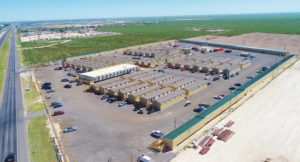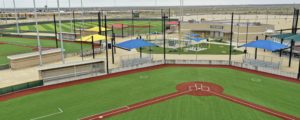 Places in Texas like Odessa, Midland, and Pecos, or places in New Mexico like Hobbs, Carlsbad, or Artesia, have much going for them in terms of quality jobs, high pay, and career opportunities. Those locales also have much going for them in other ways—in being home to great people, strong communities, and good values. Yes, there are also local characteristics that give pause to some who might otherwise choose to live here. There are desert environs and a lack of lushness and striking natural beauty such as can be found in some other regions. There is a relative lack of cosmopolitan swank and metro sophistication. But few regions do a better job of offsetting their potential drawbacks than do the corporations and communities of the Permian Basin.
Places in Texas like Odessa, Midland, and Pecos, or places in New Mexico like Hobbs, Carlsbad, or Artesia, have much going for them in terms of quality jobs, high pay, and career opportunities. Those locales also have much going for them in other ways—in being home to great people, strong communities, and good values. Yes, there are also local characteristics that give pause to some who might otherwise choose to live here. There are desert environs and a lack of lushness and striking natural beauty such as can be found in some other regions. There is a relative lack of cosmopolitan swank and metro sophistication. But few regions do a better job of offsetting their potential drawbacks than do the corporations and communities of the Permian Basin.
This is the country of adaptability, resourcefulness, and spirit.
Despite whatever drawbacks this country might have, it is arguably the most advanced in terms of compensatory actions and achievements. The innovation and application show by local entities in improving living conditions and raising the standard of living is likely unmatched anywhere.
Think, for example, of the explosion of temporary housing that marked the middle years of the 2010s decade. That building boom amazed everyone. And the buildout of corporate headquarters and other facilities—often with gyms, daycare centers, and other perks—was unprecedented.
The Permian Basin has always been a place of booms and busts, but the booms of this period known as the Shale Miracle have been booms that created new high-water marks in terms of appeal, beauty, and generosity.
Not only do E&P companies and service companies in the Permian oil and gas world out-do themselves in corporate largesse aimed at lifting the work and home life of workers, they funnel vast wealth into the public works of these regions, making schools, public venues, parks, programs, and other causes all better for the difference. And the wealth is spread around here like nowhere else. Public and private facilities in the Basin area are known for their generosity and outreach in making their services available to the widest spectrum of users possible.
Currently we are not in a buildout of corporate housing quite like we saw seven or more years ago, but the gains we’ve seen have been retained, and more keep being added even today. While there are no giant announcements—nothing on the scale of, say, a new company town being built somewhere—the changes we continue to see all bear the mark of high quality and good taste.
What we share here is not a roundup of all that’s happened, but rather a sampling of some of the kinds of projects in the community—especially the Texas side of the Basin—that continue to give evidence of the Permian’s own brand of hospitality.
Employee Lodging
 The phenomenon known as “man camps” has come under plenty of criticism, not just here in the Permian Basin but in other oil-rich regions like the Bakken. But whatever the knocks against them, no one who is otherwise without shelter is likely to criticize them much. It’s easy to say what is not ideal about a temporary housing facility, but imagine what worklife in the Basin would be without them—and would that life be any cleaner, better, more civilized? Hardly.
The phenomenon known as “man camps” has come under plenty of criticism, not just here in the Permian Basin but in other oil-rich regions like the Bakken. But whatever the knocks against them, no one who is otherwise without shelter is likely to criticize them much. It’s easy to say what is not ideal about a temporary housing facility, but imagine what worklife in the Basin would be without them—and would that life be any cleaner, better, more civilized? Hardly.
Permian Lodging is just one of a handful of companies that maintain temporary lodging facilities for companies and their workers in the Permian. With locations in Big Spring, Midland, Monahans, Pecos, Orla, and Carlsbad (N.M.), Permian Lodging has quietly built its network into a force within its niche.
Permian Lodging was founded in 2012 “to provide industry-leading lodging that promotes productivity and satisfaction,” according to its leadership. They assert that their priority is to “optimize [your] workforce through employee satisfaction and retention.”
The company prides itself on its network of on-site Cafés and One-Stop Shops that allow for convenience and connectivity without ever having to leave the grounds.
Another firm, Aries Residence Suites, specializes in developments that are somewhat smaller, but, as with those at Permian Lodging, are close to the action. Aries’ most recent facility is about six miles north of Orla, Texas, or roughly 30 miles from Pecos. This workforce housing site includes lodges and cottages. The lodge is split into two sections with one area built as a camp and the other section built as a cabin/cottage area. Management at Aries say that they hope their facility will help cut down on drive times for its workers and thus improve road safety in the region.
Sports and Leisure
A good example of upgrades happening in the community/cultural sphere of the Basin is found in a recent announcement from the University of Texas, Permian Basin. UTPB stated that their Basin Sports Complex, formally known as The UTPB Park, officially reopened with a big celebration for the community. The complex, now managed by Sports Facilities Companies (SFC), welcomed hundreds of members of the West Texas community this past spring to enjoy a beautiful day with a kite festival, softball and flag football games, bounce houses, and prizes.
After field renovations and improvements, new fencing, and other updates, The Basin Sports Complex offers sports programs, games, pavilion and field rentals, and events to their community. More improvements and renovations are planned for the venue in the near future. Many programs for youth and adults will be available to reintroduce sports in the Midland-Odessa community. With 12 softball/baseball fields, two tee-ball fields, 12 adult soccer fields or 36 youth soccer fields, one basketball court, one sand volleyball court, one tennis court, four event pavilions, and a playground, the complex will bring events, vendors, partners, and programming opportunities to the West Texas community.
Another local (Midland) landmark, the Bush Tennis Center, is itself in the midst of a massive expansion that will make it of greater value than ever to the community—not just for tennis, but for many other sports and diversions.
Construction will soon begin at the Bush Tennis Center, which now sits on a 35-acre campus, that will transform the premier tennis facility into the region’s premier athletic complex.
Already equipped with 19 full size lighted courts, including a stadium court, two quick-start junior courts, and six pickleball courts, Bush Tennis Center is a world class facility second to none in Texas. Upon its completion the tennis center will be the second-largest such facility in the world, with more than 60 courts, including covered courts and indoor clay courts.
But there’s more.
Pioneer Natural Resources (already) donated three acres for the complex, which will allow the Bush ACE Athletic Center to be home to a track and lacrosse field.
Other improvements in the works include five indoor basketball/volleyball courts, a 50-yard indoor turf room, and a 12,000-square-foot, high-performance training facility designed by Lance Hooten.
The Bush A.C.E. Outreach Program has provided free or discounted tennis programs for more than 40,000 children through the Permian Basin. In 2019, the Bush A.C.E. Outreach Program expanded through partnerships with UTPB, Baylor and Texas A&M, according to the Bush Tennis Center website.
Pecos, Too
Few places have seen as many changes in ten years as has Pecos, Texas.
One of the brightest spots, for residents of that area, is the new Cyclone Ballparks facility, an outdoor sports complex that includes baseball/softball diamonds, batting cages, concessions and more. Organizers expect it to do more than furnish recreation—they believe it can attract tourism as well.
Altogether, the project boasts 50 acres encompassing five diamond fields. Cyclone Ballparks opened last year. The Town of Pecos City selected Sports Facilities Companies—the same company that manages UTPB’s facility—as the turn-key service provider to manage the ballpark.
 Heather Ramirez, Interim Pecos City Manager, said, “This project is something the council has been dreaming about for years and we look forward to executing our vision with SFC to transform our town into a baseball destination. Cyclone Ballparks will be the catalyst for a new era in our region as we expand on our legacy of industrial and agricultural history.”
Heather Ramirez, Interim Pecos City Manager, said, “This project is something the council has been dreaming about for years and we look forward to executing our vision with SFC to transform our town into a baseball destination. Cyclone Ballparks will be the catalyst for a new era in our region as we expand on our legacy of industrial and agricultural history.”
Again, this is only a sampling of the state of the Basin, where lifestyle and accommodations are concerned. This might be a region of booms and busts, but the booms are certainly ratcheting the liveability factor, bit by bit.










